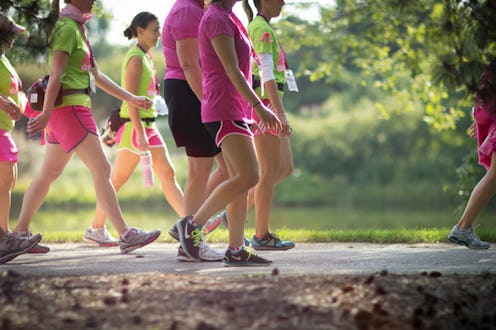Life
5 Facts To Know For Breast Cancer Awareness Month

This month is Breast Cancer Awareness Month, and there is plenty to be aware of when it comes to this disease. For starters, breast cancer is the second-most common cancer in the United States after nonmelanoma skin cancer. About one in eight women will be diagnosed with breast cancer at some point during her lifetime. In the United States, an estimated 231,840 women will be diagnosed with breast cancer for the first time this year. That's enough women to fill up America's largest football stadium 2.15 times with newly diagnosed women from this year alone.
But breast cancer is not solely a women's health issue. Though breast cancer is a little more than 100 times less common in men, about one man in every 1,000 will contract the disease in his lifetime. The five year survival rates (calculated based on the stage at which each patient is diagnosed) are very similar for men and women. The medical statistics certainly don't take into account the hundreds of thousands of children and loved ones who are impacted by the ripples of having a sick mother, sister, wife, or friend.
So, what else should we know about this enormously prevalent disease, and what we can do to minimize the damage it causes going forward? Here are five facts to know this Breast Cancer Awareness Month.
1. Who is at risk of contracting breast cancer?
The two biggest risk factors for developing breast cancer are, unsurprisingly, being female, and getting older, though about 0.1 percent of men will contract breast cancer during their lifetime. Women with a family history of the disease have a 20 to 25 percent higher risk of being diagnosed than their counterparts with no such history.
2. What is the median age of diagnosis for breast cancer?
The median age of first diagnosis for breast cancer is 61 years old. Still, seven percent of women diagnosed with breast cancer are under the age of 40 — cases which will account for more than 16,000 new breast cancer patients in 2015.
3. At what age should I have my first mammogram?
The medical community stands firm that women over the age of 50 should receive regular mammograms. There is somewhat of a debate still over mammograms between ages 40 and 49, as the density of breast tissue before menopause often interferes with the mammography images. Because of the density of breast tissue in younger women, doctors recommend that women in their 20s and 30s receive a clinical breast exam once every three years. That means most of us have another 20 or so years before we need to schedule our first mammogram.
4. What should I know about early detection?
Before and after age 40, the Susan G. Komen Foundation recommends being aware of early warning signs of breast cancer which include swelling, discharge from the nipple, puckering of breast skin, and more. Be aware of what is normal for your body. Get to know the locations of fat deposits and other completely normal features of your breasts (sexy, huh?). If you do notice something out of the ordinary, schedule a clinical breast examination.
5. How can I volunteer my time and money to finding a cure?
There are loads of organizations that donate to breast cancer research. One of the most popular organizations is the Susan G. Komen Foundation which hosts around 150 Race For The Cure races around the world annually (at which you can volunteer!). The Foundation accepts donations of both time and money, which is perfect for young people who want to get started participating in this extremely important cause.
Other organizations that support breast cancer research include:
Breast Cancer Research Foundation
Dr. Susan Love Research Foundation
and many, many more!!
With just a bit of research, you can decide which foundation you'd like to support with your dollars or your hours, and help kick breast cancer's butt this October.
Images: susangkomenforthecure/Flickr; Giphy (2); mugglenet/Tumblr; sesen/Flickr